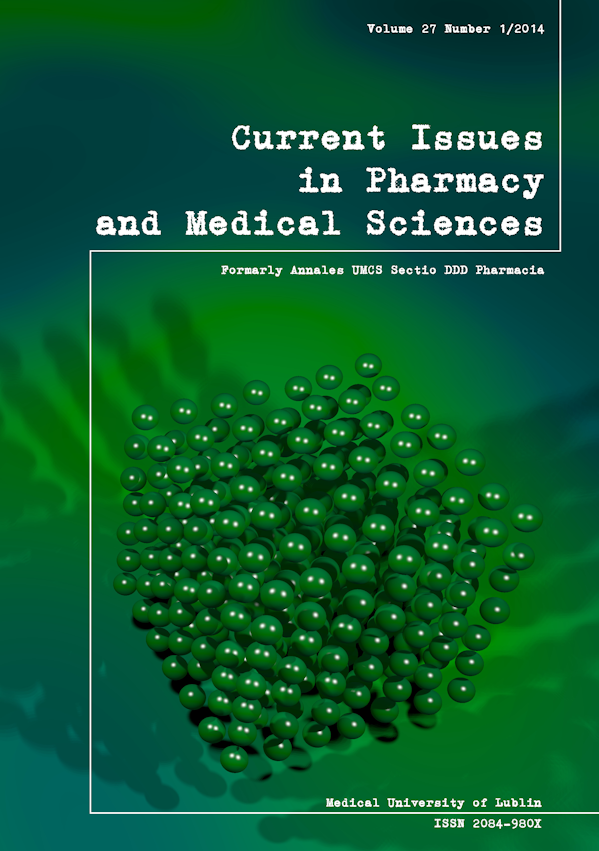FAPA mass spectrometry of hydroxychalcones. Comparative studies with classical methods of ionization
DOI:
https://doi.org/10.2478/cipms-2014-0008Keywords:
mass spectrometry, hydroxychalcones, FAPAAbstract
In this paper we are focused on analysis of hydroxychalcones, i.e. 2’ –hydroxychalcone, 3’ –hydroxychalcone and 4’ –hydroxychalcone, by the Flowing Atmospheric Pressure Afterglow mass spectrometry (FAPA-MS), and on comparison of the obtained data with other classical methods including ESI-MS, APCI, MALDI, and GC/EI-MS. The paper is presenting fragmentation pathways of both positive-, and negative hydroxychalcone ions. Tested compounds were characterized by comparison of the results (signals m/z and relative intensities) from the five mass spectrometry techniques, showing very good utility of FAPA method for fast and easy analysis of the low molecular weight compounds. Moreover, FAPA does not require a time-consuming derivatization, nor search for a suitable solvent or matrix, often incompatible with various ion sources.
References
1. S. Alam, S. Mostahar. Studies of Antimicrobial Activity of two Synthetic 2’,4’,6’-trioxygenated Flavones. J. Applied Sci. 2005, 5, 327-333.
2. J. R. Dimmock, D. W. Elias, M. A. Beazely, N. M. Kandepu. Bioactivities of chalcones. Curr Med Chem. 1999, 6, 1125-49.
3. P. M. Sivakumar, T. Muthu Kumar, M. Doble. Antifungal activity, mechanism and QSAR studies on chalcones. Chem Biol Drug Des. 2009, 74, 68-79.
4. S. J. Won, C. T. Liu, L. T. Tsao, J. R. Weng, H. H. Ko, J. P. Wang, C. N. Lin. Synthetic chalcones as potential anti-inflammatory and cancer chemopreventive agents. Eur. J. Med. Chem. 2005, 40, 103-12.
5. E. C. Amor, I. M. Villaseñor, M. N. Ghayur, A. H. Gilani, M.I.Choudhary. Spasmolytic flavonoids from Syzygium samarangense (Blume) Merr. & L.M. Perry. Z Naturforsch C. 2005, 60, 67-71.
6. J. B. Daskiewicz, F. Depeint, L. Viornery, C. Bayet, G. Comte- Sarrazin, G. Comte, J. M. Gee, I. T. Johnson, K. Ndjoko, K.Hostettmann, D. Barron. Effects of Flavonoids on Cell Proliferation and Caspase Activation in a Human Colonic Cell Line HT29: An SAR Study. J. Med. Chem. 2005, 48, 2790-2804.
7. F. J. Andrade, J. T. Shelley, W. C. Wetzel, M. R. Webb, G. Gamez, S. J. Ray, G.M. Hieftje. Atmospheric Pressure Chemical Ionization Source. 2. Desorption-Ionization for the Direct Analysis of Solid Compounds. Anal. Chem. 2008, 80, 2654-2663.
8. M. Smoluch, K. Labuz, E. Reszke, A. Ramsza, K. Labuz, J. Silberring.Direct analysis of methcathinone from crude reaction mixture by flowing atmospheric-pressure afterglow mass spectrometry. Rapid Commun. Mass Spectrom. 2012, 26, 1577-1580.
9. M. Smoluch, E. Reszke, A. Ramsza, J. Silberring. Development of a novel ambient glow discharge plasma source for direct analysis of organic compounds. In: Biomacromolecular Mass Spectrometry: Tips from the Bench (S. König, ed.) Nova Science Publ. 2012, ISBN: 978-1-62081-933-3.
10. Y. Tai, S. Pei, J. Wan, X. Cao, Y. Pan. Fragmentation study of protonated chalcones by atmospheric pressure chemical ionization and tandem mass spectrometry. Rapid Commun. Mass Spectrom. 2006, 20, 994-1000.
11. J. Zhang, J. S. Brodbelt. Structural characterization and isomer differentiation of chalcones by electrospray ionization tandem mass spectrometry. J Mass Spectrom. 2003, 38, 555-72.
Downloads
Published
Issue
Section
License
Copyright (c) 2014 Authors

This work is licensed under a Creative Commons Attribution-NonCommercial-NoDerivatives 3.0 Unported License.


